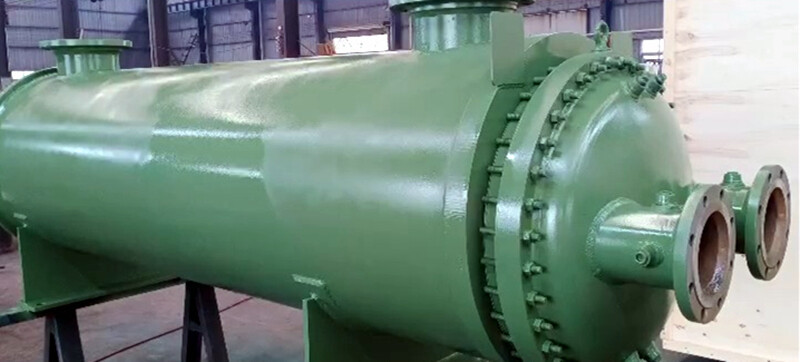Heat Exchange Equipment For Oil Refinery
In refineries, heat exchange equipment (Shell and Tube Heat Exchangers) is one of the most widely used heat transfer equipment, its core function is to exchange heat between two different temperature process media (such as crude oil, distillate, steam, cooling water, etc.) through the tube wall to achieve the process goals of heating, cooling, condensation or evaporation. Refinery processes (such as crude oil distillation, catalytic cracking, hydrogenation refining, delayed coking, etc.) involves a large number of high and low temperature media energy transfer, shell and tube heat exchanger due to the structure of the strong, adaptable to high temperature and high pressure, large capacity, easy to maintain and so on, it has become a key energy saving and process security equipment.

Refinery shell and tube heat exchanger workflow needs to be combined with specific process scenarios, the core of the “high temperature medium through the tube wall to transfer heat to the low temperature medium”.
1. Crude oil distillation unit: crude oil preheating (energy saving core link)
Crude oil distillation is the first process in refineries, which needs to heat cold crude oil (e.g. 20-40℃) to 300-360℃ and then send it to atmospheric pressure tower for distillation. Direct heating with fuel consumes a lot of energy, so it is necessary to preheat the crude oil by using the waste heat of each distillate through the **“heat transfer network ”**, and the shell-and-tube heat exchanger is the core equipment of this network:
Tubular medium: Cold crude oil (large flow rate, viscosity decreases with temperature, and it is easy to be scaled at the initial stage).
Shell medium: high-temperature distillate (such as atmospheric pressure tower bottom heavy oil, the temperature of about 350 ℃; or decompression tower top oil and gas condensing hot oil, the temperature of about 200 ℃).
Workflow:
Cold crude oil from the pipe process inlet into the header, through the partition plate is allocated to the bundle of multi-process piping (such as 4-process, to extend the heat transfer path);
High-temperature distillate oil from the shell process inlet into the shell, in the folding plate guided by the transverse scouring of the pipe bundle outer wall (folding plate to force the medium around the pipe flow, to avoid the “dead zone”, to improve the heat transfer coefficient);
High-temperature The heat of the medium is transferred to the cold crude oil in the tube through the tube wall, the temperature of the shell process medium is lowered (e.g., from 350℃ to 250℃), and the temperature of the crude oil in the tube process is increased (e.g., from 40℃ to 200℃);
The preheated crude oil enters into the next heat exchanger (exchanging heat with a higher-temperature medium) and eventually reaches the temperature required for distillation; and the cooled down distillate oil enters into the subsequent process (e.g., cooled storage or secondary processing).
2. Catalytic Cracking Unit: Slurry Cooling and Steam Generation
Catalytic cracking is a key process for converting heavy oil into gasoline and diesel. The reaction products (such as slurry, with a temperature of about 350-400℃) need to be cooled down and then recycled or sent out, and at the same time, steam can be generated by using the residual heat (recovering energy):
Scene A: Slurry Cooling
Pipe Process: Recycled Cooling Water (or light diesel, with a temperature of about 30℃);
Shell Process: High-temperature slurry (containing catalyst particles, prone to coking). Shell process: high temperature oil slurry (containing catalyst particles, easy to coking, need to control the flow rate to prevent deposition);
process: oil slurry in the shell process through the refractory plate to form turbulence, the heat will be transferred to the cooling water in the pipe, the oil slurry cooled down to 200-250 ℃ (to meet the requirements of the circulating pump delivery), the cooling water warmed up to be sent to the cooling tower cooling cycle.
Scenario B: Waste Heat Steam Generation
Tube process: deaerated water (temperature about 100℃, used to generate steam);
Shell process: high temperature oil slurry (380℃);
Process: the heat of the oil slurry makes the deaerated water in the tube heated to boiling, and produces saturated steam (e.g., 1.0MPa, 180℃), which is converged into the steam pipe network and used for power generation or process heating to realize energy recovery.
3. Hydrogenation and refining unit: cooling and condensation of reaction products
Hydrogenation and refining through hydrogen in the catalyst to remove sulfur, nitrogen and other impurities in the oil, the reaction is exothermic, the product (temperature of about 300-350 ℃) need to be cooled after the separation of hydrogen and refined oil:
pipe process: the cold air of the circulating water or air cooler (low temperature medium);
shell process: hydrogenation reaction products (containing hydrogen, refined oil, a small amount of water, high pressure) Shell process: hydrogenation reaction products (containing hydrogen, refined oil, small amount of water, high-pressure environment, e.g., 3-10MPa);
process: high-temperature reaction products enter the shell process, heat exchange with low-temperature medium in the tube, the temperature is reduced to 40-50 ℃ (at this time, the oil and water phases condense into liquid), and then enter the separator to separate hydrogen (recycling), refined oil and waste water.
4. Delayed coking unit: oil and gas condensation at the top of coke tower
Delayed coking converts heavy oil into coke and light oil, and the oil and gas discharged from the top of coke tower (temperature of about 400-450℃, containing gasoline, diesel fuel, and other fractions) needs to be condensed into liquid:
Pipeline: circulating cooling water (or low-temperature diesel fuel);
Shell: high-temperature oil and gas (containing coking-prone fractions, which needs to be controlled by the flow rate and temperature to prevent scaling);
Flow: oil and gas flows uniformly through a bundle of tubes and pipes through folding plate in the shell; Process: oil and gas flows uniformly through a bundle of tubes and pipes through folding plate. Flow: oil and gas in the shell process through the folding plate flows evenly through the tube bundle, the heat is absorbed by the cooling water inside the tube, the oil and gas condensation for the mixed distillate (temperature down to 100-150 ℃), sent to the fractionation tower for further separation, the cooling water after warming up to the cooling tower cooling cycle.

